3rd Part in a Series of 3 (DENR in mock Battle for Manila Bay rehab?)
Read the 1st Part: Bulacan fisherfolk, women want genuine, inclusive Manila Bay rehabilitation
2nd Part: ‘Direct hit’ Bulacan fisherfolk most affected, least consulted on SMC reclamation
This is one of the reports in a series produced by Bulatlat.com with the Asia-Pacific Forum on Women, Law and Development (APWLD) Media Fellowship. The series aims to report on linkages between gender, ecological conflicts and climate change.
“If anyone had rights over the Manila Bay, it is the Filipino people, and if it is to serve any purpose, it should be for the benefit of the general population, and not an elite few.” — Makabayan lawmakers
By MARYA SALAMAT
Bulatlat.com
MANILA — Bucking threats from local government leaders and intermittent military “visibility” in their communities, members of the fisherfolk communities in Bulacan have protested the proposed reclamation affecting their homes and fishing grounds. “Buo sa isip ko, kaya namin lumaban (I’m entirely sure in my mind that we can oppose this),” fisherwoman and spokesperson of Network Opposed to Reclamation in Bulacan Monica Anastacio, 63, told Bulatlat in Filipino.
They have questioned since last year what they considered as initial steps to reclamation, the massive cutting of mangrove trees serving San Miguel Corporation’s proposal to do away with their communities and build an international airport on today’s river and villages. Despite the support to this project by their local government officials, they organized a Network Opposed to the Aerotropolis and Reclamation in Bulacan on October 2018.
With support of their fishermen, the women comprised the network’s unanimous choice as spokespersons to help convene the rest of the affected villagers for the defense of the bay, and to represent them as well in dialogues or forum in the mainland. They launched the campaign to #SaveTaliptip in early 2018.
Supported by the multisectoral Alyansa para sa Pagtatanggol ng Kabuhayan, Paninirahan at Kalikasan sa Manila Bay (AKAP KA-Manila Bay), the Bulacan fisherfolk launched a petition against reclamation since late 2018. They sent delegations to various pickets and dialogues held at the national headquarters of the Department of Environment and Natural Resources (DENR). They spoke at peoples’ conferences on climate change, on land use and food security.
“Malaking kawalan sa lahat pag pumayag tayo tabunan,” (It will be a huge loss for everyone if we agree to reclamation) a priest from the Bulacan Ecumenical Forum who grew up catching fish and seafood in Taliptip told a gathering of residents in Taliptip.
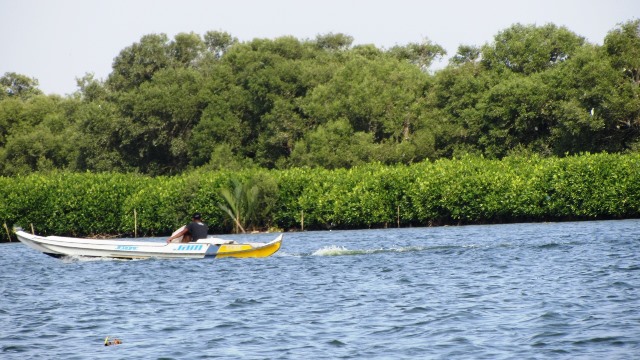
The communities in Taliptip are united not just in protecting the mangroves but also in opposing moves to displace the fisherfolk in favor of a private company’s reclamation, according to Monica Anastacio, a resident of Taliptip for over 50 years. To them it is not just a call for saving their homes or sources of livelihoods for themselves. They believe other Filipinos in the mainland also stand to lose when the mangroves and the relatively affordable sources of nutritious fish and seafood are buried under concrete.
She has worked with her family in Taliptip saltbeds since she was in grade school. When the salt farms stopped operation in 1990s, she and her husband turned to fishing. The women in these coastal communities are used to working with their husbands, from the saltfarms of decades ago to today’s fishing.
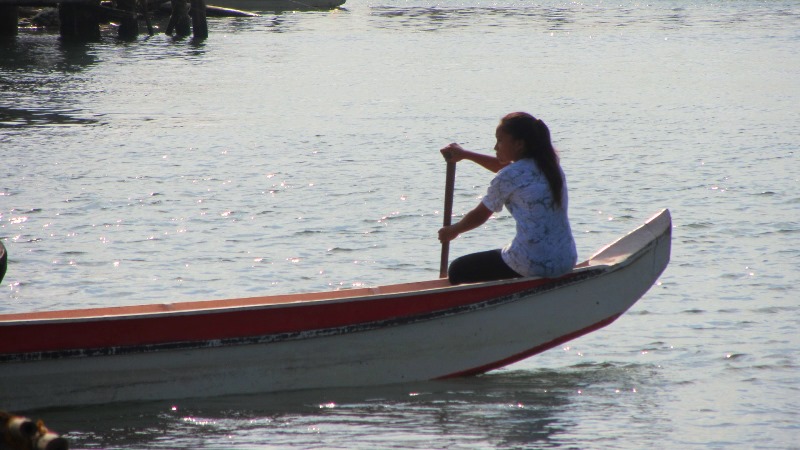
While fishing is traditionally a male occupation in the Philippines, it is not uncommon to see women at work, too, setting traps (for crabs), casting nets, rowing the family’s banca, or selling the fish catch. Some women also go down to the river or out on the bay to catch fish. Some wade into the muddy, shallow loam to catch crabs. These days they add to their responsibilities of taking care of their household and family various tasks toward network-building to turn the rehabilitation of river and the bay to the people’s favor.
Their background of being saltfarmers and fisherfolk speaks of how much food the areas where they live now have contributed and could further contribute to the country’s food needs.
The coastal communities in Bulakan were major contributors to the country’s salt sufficiency for decades. Until 1990s, Bulacan was producing more than a hundred metric tons of salt, equivalent to more than half the country’s needs. That is, until a combination of the impact of climate change and trade liberalization began eroding the industry to a pale shadow of itself at present. Nowadays, the fisherfolk group Pamalakaya says the government’s approval of reclamation projects also threatens the country’s food security, along with other policies that ultimately shrink the fishing grounds and mangroves and remove the fisherfolk from the coasts.
Facing the threat of displacement due to reclamation, the women of Bulakan are facilitating their organizing and network formation for an organized response. Now they are also finding time to ride their bancas and visit their neighboring fishing communities in hopes of strengthening their network opposing the reclamation of their coastal villages.
Asked why it is the women frequently being sent to represent the fisherfolk in outside forum and dialogues, they replied that the menfolk are working with them and supportive, but the tasks of representation can be squeezed along with their other duties such as taking care of the household, selling the fish catch and procuring supplies.
Threats Not only in Bulacan but along entire Manila Bay
What is threatening to happen in Bulakan and neighboring coastal towns is happening under similar projects around the Philippines, said Jam Pinpin, spokesperson of Pamalakaya.
A total of 43 reclamation projects covering more than 32, 000 hectares are pending throughout the 194, 400-hectare Manila Bay, based on record obtained by Pamalakaya from the Philippine Reclamation Authority (PRA).
In Bulacan the SMC has won over the local government executives. Even as it has yet to conclude a concession agreement with the government (for the proposed airport), its subcontractors are already at work readying the ground for reclamation. It is now at the final stages in the process of securing an ECC (Environmental Compliance Certificate) that will pave the way to reclamation of over 2,500 hectares. It was suspected to have been behind the massive cutting of old-growth mangroves in April 2018. This month as we write, the residents of nearby villages of Obando posted in Save Taliptip’s social media account that strangers were knocking on their doors asking them the sizes of their house and telling them they will have to leave soon.
In Manila, the Department of Public Works and Highways (DPWH) announced last week it will start dredging in the Baywalk area of the Roxas Boulevard in March, saying it is part of the ongoing rehabilitation drive of Manila Bay.
But national fisherfolk group Pamalakaya warned that the targeted area for dredging also happens to be the area where the 148-hectare Manila Solar City reclamation project that will occupy 3.5 kilometers of Manila Bay’s shoreline will be located.
It brings a bitter déjà vu to the fisherfolk leader. He recalled that shortly before the SM Mall of Asia and Entertainment City establishments in Roxas Boulevard began construction years before, there was also some dredging work that resulted to the displacement of more than 6,000 fishing and urban poor families.
In Cavite, a province south of Manila, the coastal villages of mainly fisherfolk are also in a constant battle to save their community and livelihood. At least four reclamation projects covering hundreds to thousands of hectares of Cavite coastlines are being processed by the Philippine Reclamation Authority.
Unlike in Bulacan where the Manila Bay is still bounded by an expanse of alternating shallow loam/islets, a network of rivers and patches of mangroves, in Cavite, only a thin stretch of the shore remains between the bank that has been cemented for road and real estate development and the Manila Bay. Living on what’s left of this narrow shore the fisherfolk communities organized under Pamalakaya have been protesting reclamation and their demolition. They have suffered at least four incidences of suspected arson.
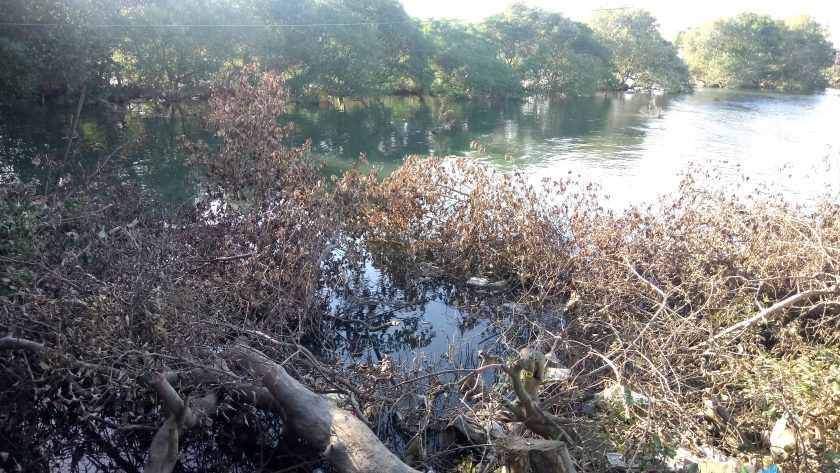
In advancing their defense of the bay, they pointed to documents from the government’s Environmental Management Bureau (EMB) itself state that the reclamation projects will have ecological impacts in Manila Bay.
It says that throughout the construction of the various projects, contaminants from dredged sediments will be released, deplete dissolved oxygen, and destroy natural habitats of sardines and mangroves found in Manila Bay. Once finished, the projects will interfere with the natural tide flow of water in the area and erode the shoreline of nearby beaches. The erosion could cause flooding in nearby low-lying areas especially during a typhoon.
Worse flooding has also been recorded in coastal towns of Bulacan since the reclamation of Manila Bay. The fisherfolk group Pamalakaya urged the government to take heed of its own environmental bureau’s assessment.
Based on the assessment of environmentalists and fisherfolk, the government’s ‘Battle for Manila Bay’ is turning out to be another mock battle for rehabilitation.
“With the recent actions of administration such as justifying reclamation projects and the abrupt issuance of Executive Order 74, or the taking over of the power to approve such projects and command of the Philippine Reclamation Authority (PRA), “Manila Bay rehabilitation” is becoming synonymous to “Manila Bay reclamation,” said Anakpawis party-list Rep. Ariel Casilao.
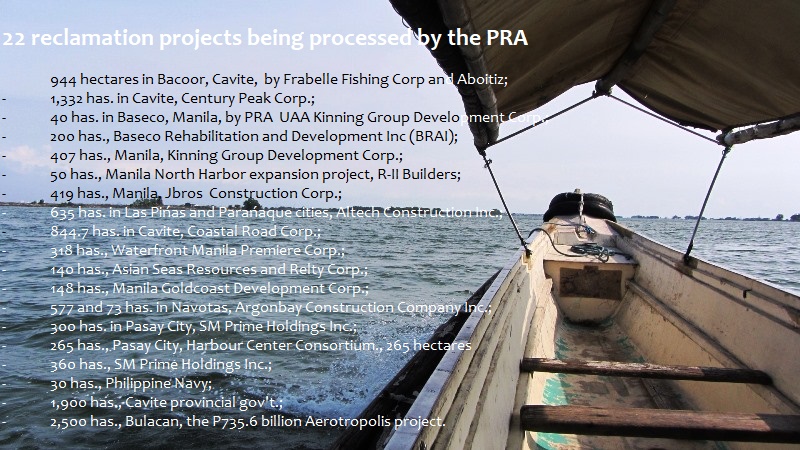
Environment Secretary Frank Cimatu denied this just this week. But around the same time he was saying these to reporters, Manila Mayor Joseph Estrada was defending and even extolling the reclamation projects.
Anakpawis’ Casilao said all these are a serving as a challenge for the people to advance a genuine rehabilitation of Manila Bay.
“If anyone had rights over the Manila Bay, it is the Filipino people, and if it is to serve any purpose, it should be for the benefit of the general population, and not an elite few,” read a part of the explanatory note when the Makabayan bloc of partylist lawmakers filed this February 7 the House Bill 9067 declaring Manila Bay as Reclamation-free Zone.
The proposed law criticized not only the duplicity in the Duterte administration’s conduct of “rehabilitating” Manila Bay – Anakpawis Partylist said it’s just a façade for facilitating reclamation and taking the bay away from the people. After years of previous reclamation, the ordinary people’s access now to the famed Manila Bay has been reduced to a few kilometers near Rajah Sulayman – and even there the poor are banned from swimming.
In Cavite, Pamalakaya’s Hicap rued said what used to be miles of cheap sources of clams and mussels are now concrete roads that could have been built elsewhere.
Makabayan lawmakers from Anakpawis, Bayan Muna, Gabriela, ACT and Kabataan Partylist traced how, through years of previous reclamation, “Development” along Manila Bay, has wiped out the mangrove ecosystem, from as broad as 54,000 hectares at the turn of the 20th century, to a measly 794 hectares in 1995.
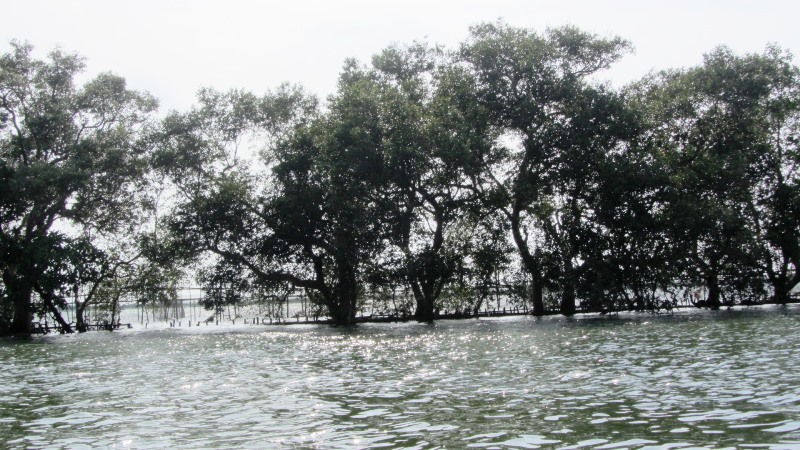
“Companies destroy mangroves because they saw no profit in maintaining it,” the Makabayan lawmakers said. And after reclamation the ordinary citizens also lose access to what remains of the bay.
“It is as clear as the blue sky of Manila Bay’s horizon that reclamation has deprived the people of public access,” Makabayan said in seeking to declare Manila Bay as reclamation-free zone.
Last February 22, a broad alliance and watchdog for genuine rehabilitation and against reclamation projects was launched in Malate Church near the last remaining free baywalk in Manila Bay. The watchdog seeks to garner support to declaring Manila Bay as a “reclamation-free” zone.
They hope that with the proposed law in Congress and the people’s movement and campaigns, they can refute any ruse of any group or even by the government “that worships profit at the cost of undermining the people’s aspiration for a sincerely-rehabilitated, restored and preserved Manila Bay.
The post Defending rivers and Manila Bay against pollution, privatization appeared first on Bulatlat.




